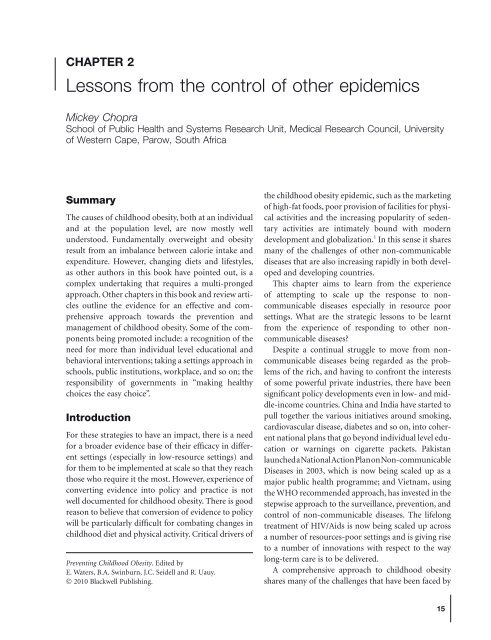Preventing Childhood Obesity - Evidence Policy and Practice.pdf
Preventing Childhood Obesity - Evidence Policy and Practice.pdf
Preventing Childhood Obesity - Evidence Policy and Practice.pdf
You also want an ePaper? Increase the reach of your titles
YUMPU automatically turns print PDFs into web optimized ePapers that Google loves.
CHAPTER 2<br />
Lessons from the c ontrol of o ther e pidemics<br />
Mickey Chopra<br />
School of Public Health <strong>and</strong> Systems Research Unit, Medical Research Council, University<br />
of Western Cape, Parow, South Africa<br />
Summary<br />
The causes of childhood obesity, both at an individual<br />
<strong>and</strong> at the population level, are now mostly well<br />
understood. Fundamentally overweight <strong>and</strong> obesity<br />
result from an imbalance between calorie intake <strong>and</strong><br />
expenditure. However, changing diets <strong>and</strong> lifestyles,<br />
as other authors in this book have pointed out, is a<br />
complex undertaking that requires a multi - pronged<br />
approach. Other chapters in this book <strong>and</strong> review articles<br />
outline the evidence for an effective <strong>and</strong> comprehensive<br />
approach towards the prevention <strong>and</strong><br />
management of childhood obesity. Some of the components<br />
being promoted include: a recognition of the<br />
need for more than individual level educational <strong>and</strong><br />
behavioral interventions; taking a settings approach in<br />
schools, public institutions, workplace, <strong>and</strong> so on; the<br />
responsibility of governments in “ making healthy<br />
choices the easy choice ” .<br />
Introduction<br />
For these strategies to have an impact, there is a need<br />
for a broader evidence base of their efficacy in different<br />
settings (especially in low - resource settings) <strong>and</strong><br />
for them to be implemented at scale so that they reach<br />
those who require it the most. However, experience of<br />
converting evidence into policy <strong>and</strong> practice is not<br />
well documented for childhood obesity. There is good<br />
reason to believe that conversion of evidence to policy<br />
will be particularly difficult for combating changes in<br />
childhood diet <strong>and</strong> physical activity. Critical drivers of<br />
<strong>Preventing</strong> <strong>Childhood</strong> <strong>Obesity</strong>. Edited by<br />
E. Waters, B.A. Swinburn, J.C. Seidell <strong>and</strong> R. Uauy.<br />
© 2010 Blackwell Publishing.<br />
the childhood obesity epidemic, such as the marketing<br />
of high - fat foods, poor provision of facilities for physical<br />
activities <strong>and</strong> the increasing popularity of sedentary<br />
activities are intimately bound with modern<br />
development <strong>and</strong> globalization. 1 In this sense it shares<br />
many of the challenges of other non - communicable<br />
diseases that are also increasing rapidly in both developed<br />
<strong>and</strong> developing countries.<br />
This chapter aims to learn from the experience<br />
of attempting to scale up the response to non -<br />
communicable diseases especially in resource poor<br />
settings. What are the strategic lessons to be learnt<br />
from the experience of responding to other non -<br />
communicable diseases?<br />
Despite a continual struggle to move from non -<br />
communicable diseases being regarded as the problems<br />
of the rich, <strong>and</strong> having to confront the interests<br />
of some powerful private industries, there have been<br />
significant policy developments even in low - <strong>and</strong> middle<br />
- income countries. China <strong>and</strong> India have started to<br />
pull together the various initiatives around smoking,<br />
cardiovascular disease, diabetes <strong>and</strong> so on, into coherent<br />
national plans that go beyond individual level education<br />
or warnings on cigarette packets. Pakistan<br />
launched a National Action Plan on Non - communicable<br />
Diseases in 2003, which is now being scaled up as a<br />
major public health programme; <strong>and</strong> Vietnam, using<br />
the WHO recommended approach, has invested in the<br />
stepwise approach to the surveillance, prevention, <strong>and</strong><br />
control of non - communicable diseases. The lifelong<br />
treatment of HIV/Aids is now being scaled up across<br />
a number of resources - poor settings <strong>and</strong> is giving rise<br />
to a number of innovations with respect to the way<br />
long - term care is to be delivered.<br />
A comprehensive approach to childhood obesity<br />
shares many of the challenges that have been faced by<br />
15

















